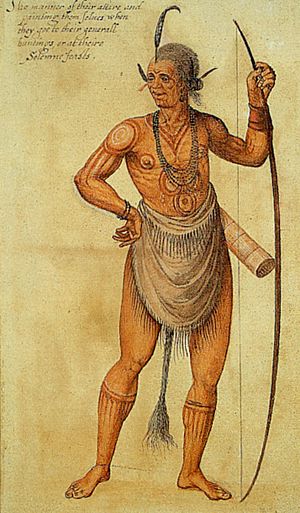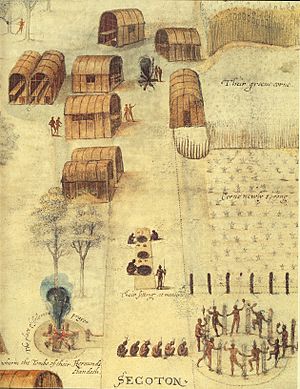Aquascogoc facts for kids
| Total population | |
|---|---|
| Extinct as a tribe | |
| Regions with significant populations | |
| North Carolina | |
| Languages | |
| Carolina Algonquian language | |
| Religion | |
| Tribal religion (historical) | |
| Related ethnic groups | |
| Secotan, Dasamongueponke |

The Aquascogoc were a Native American tribe and also the name of their village. They lived in what is now North Carolina during the late 1500s. At that time, English explorers were trying to start new settlements there, calling the area Virginia. The Aquascogoc people were part of the larger Secotan group. They also belonged to the Carolina Algonquian Indians. They spoke the Carolina Algonquian language, which is no longer spoken today. In 1585, the Aquascogoc village was burned down. This happened because Sir Richard Grenville believed they had stolen a silver cup.
Contents
Early English Encounters
The Roanoke Colony Expedition
In 1585, Sir Richard Grenville led an English expedition. His goal was to establish the first English settlement on Roanoke Island. Chief Manteo, a friendly Native American leader, guided Grenville's group. When they reached the Aquascogoc village, the villagers did not want to meet with them. The English settlers soon returned to their boats.
The Missing Silver Cup
After leaving the village, a silver drinking cup was discovered missing. The English believed the Aquascogoc people had stolen it. This made Sir Richard Grenville very angry. During heated arguments, Grenville ordered the Aquascogoc village to be burned.
Revenge and Retaliation
The Aquascogoc people later got their revenge. Sir Richard Grenville left Roanoke, leaving behind fifteen experienced English soldiers. When Governor John White returned in 1587, he looked for these fifteen men. However, he only found their bones. Chief Manteo explained what had happened. He told White that hostile warriors from the Secotan, Aquascogoc, and Dasamongueponke tribes had attacked and killed the English soldiers. They chose a time and place that gave them a great advantage.
Understanding the Past
John White's Important Art
Much of what we know about the Aquascogoc and other Algonquian tribes comes from Governor John White. He was an artist and explorer. In 1585, he was asked to "draw to life" the people and places of the New World. While on Roanoke Island, White created many watercolor paintings. These paintings showed the landscape and the Native American people.
A Unique Historical Record
White's artwork is very important. It gives us the most detailed pictures of a Native American society on the Eastern seaboard from that time. His work came before other "discovery voyage art" that appeared much later. These paintings are the only visual record we have of the Native Americans encountered by England's first settlers in America.
Sharing the Discoveries
John White preferred using watercolors, which was unusual for painters back then. Most artists used oil-based paints. White's watercolors became very popular in Europe. A famous engraver from Flanders, Theodore de Bry, made copies of the paintings. These copies were widely shared through print. They were published in 1590 in a book called "America."


